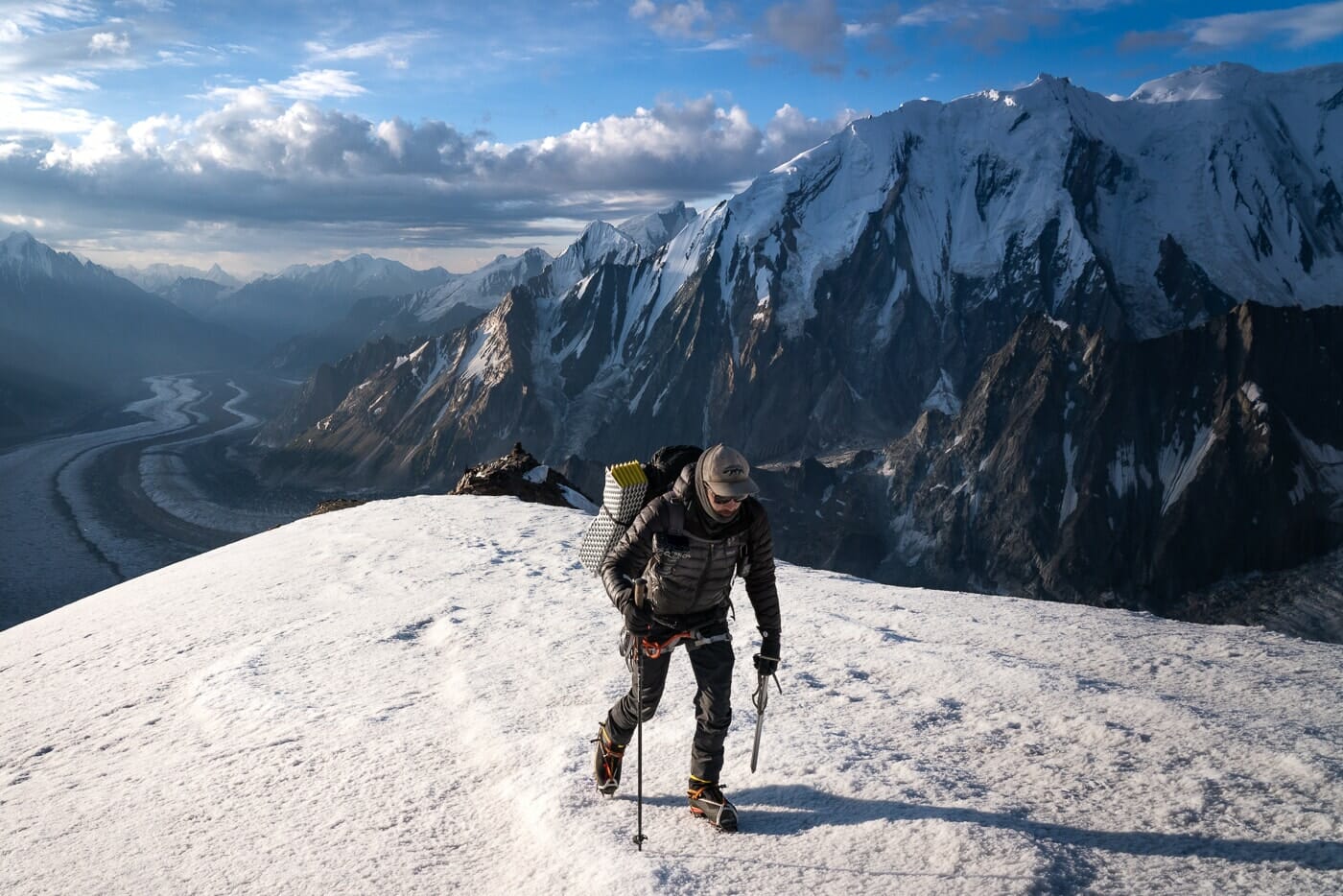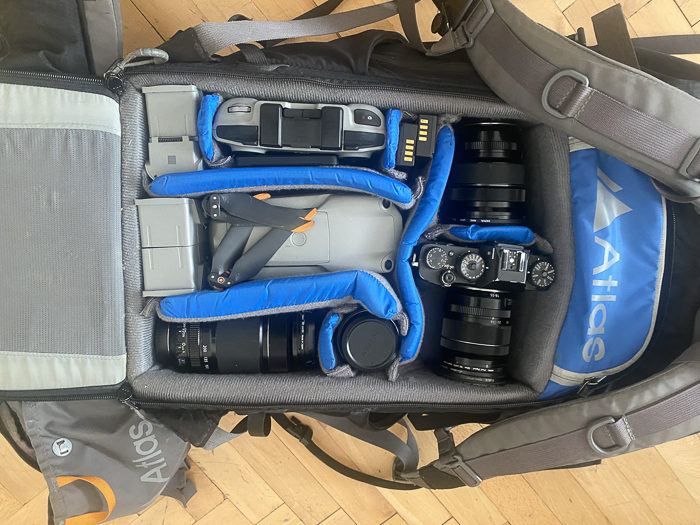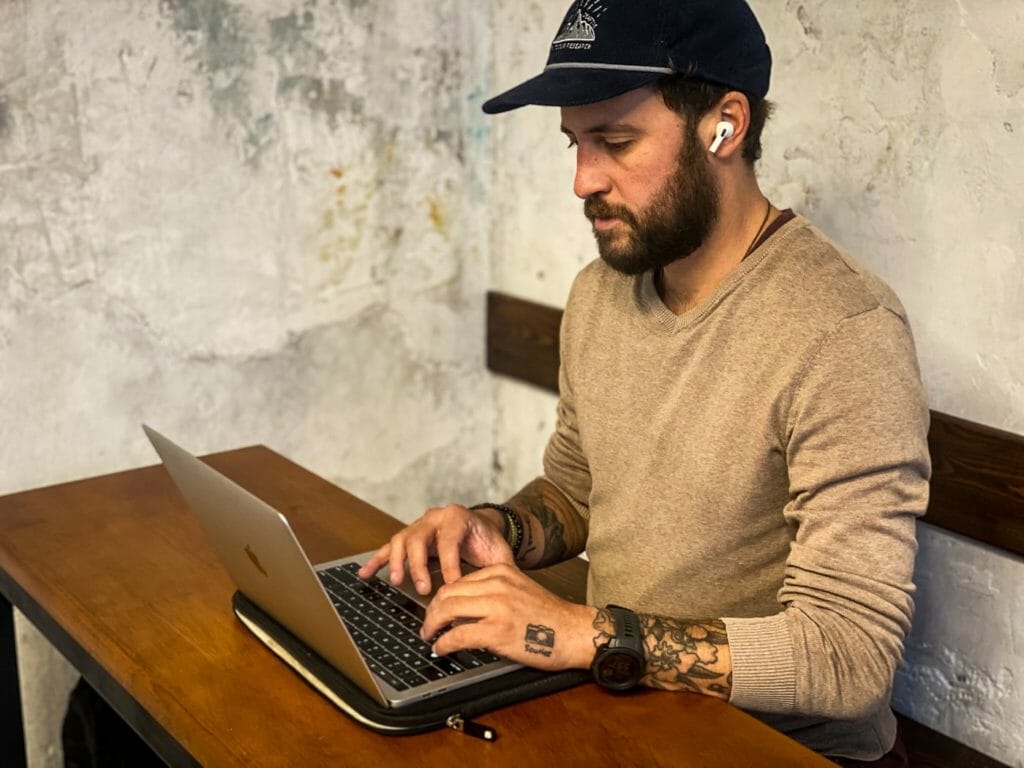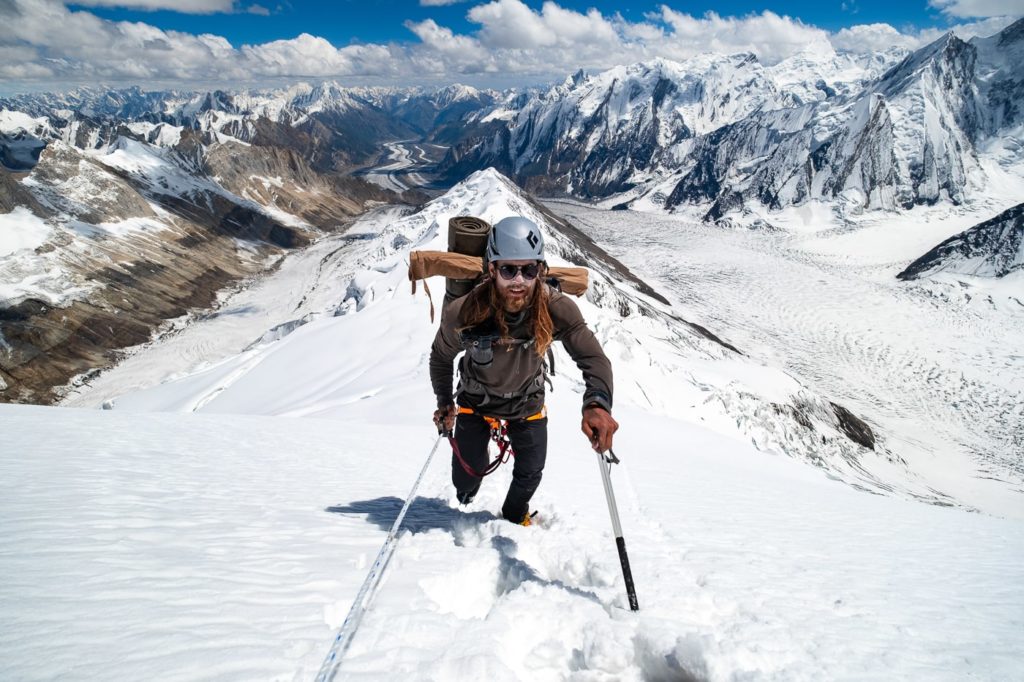What’s In My Backpack? My Ultimate Adventure Packing List

They say that two things are certain in life: death and taxes. Well in the life of a full-time photographer and adventure fanatic, I would argue that three things are certain: death, taxes, a whole lot of gear.
At this point – I should say what’s in my backpacks – because these days I have been rolling around with a minimum of 3 bags to accommodate my cameras, clothes, trekking and mountaineering gear, and my guiding kit.
Before I started Off The Atlas – I was a professional outdoor gear tester – working with all the major brands in the outdoor industry. Because of that experience, I am now super particular when it comes to my personal gear.
The gear I use needs to be practical, relatively lightweight and built to last because I am not often in countries where getting a resupply of quality gear is possible. At this point, I have my equipment systems dialed in – the product of 10 years of traveling and hiking around the world.
Hopefully, my adventure packing list will give you some ideas regarding what you can incorporate into your adventure gear inventory.
Below is a list of my absolute core gear kit – all stuff I have used personally for years…
Camera and Drone Systems

Without my cameras – what I enjoy doing is not possible. Photography is the tool that makes all the awesome images on Off The Atlas possible as well. I have tried a few setups over the years –
FUJIFILM X-T3: For my go-to camera system – I use a Fuji Film X-T3 mirrorless set up. This camera is amazing for a variety of reasons. My favorite aspects of it are the fact that it is relatively small for what it can do and it is capable of capturing the sort of photographs I want.
I carry 5 spare batteries and two Sandisk 64 gb memory cards.
Camera lenses I use:
DJI Air 2S with 5 batteries: This is my third drone in two years (crashed the other two). I was pretty happy with my Mavic Air 2 – but after an eagle attacked my drone in Shimshal, I went for the upgrade model, the Air2 S. This drone is more than capable and the smaller size means I can get pro-level quality photos and video without needing to have the heavier Mavic Pro 2.
I probably carry too many batteries – but better to have them when you need them I suppose. I suggest carrying a minimum of 3-4 spare drone batteries on multi-day trips.
I carry two 128 gb Sandisk memory cards.
Lacie Rugged Hard Drive: I have two 2 TB hard drives for backing up all my photos and videos. The Lacie Rugged hard drive has a rubber sleeve around it so it is protected from the knocks and crashes of everyday travel life.
Laptop

No blogger can survive in the world without a laptop. Without it – I’m just a guy doing epic adventures – which I am ok with too.
MacBook Pro: This is where all the magic happens. It’s got all the firepower I need to run this website, Epic Backpacker Tours, edit photos and video, have meetings, watch the occasional basketball game, and do all the other business stuff that needs doing.
Backpacks and Duffel Bags

Choosing the best travel backpack is a personal choice – but a very important one since you will be using it to move around and potentially live out of for weeks or months at a time.
Atlas Athlete 40 Camera Backpack: Before I got an Atlas Athlete pack, I must have tried 10 other camera backpack setups. None were quite right. The Atlas Athlete 40 is the best camera backpack for adventure photographers on the market – period. It combines camera accessibility and organization with a technical hiking pack fit. I don’t think I’m ever going back to another kind of pack.
Further Reading: Atlas Athlete 40 Review
Osprey Aether 65: This is the bag I use when on big multiday adventures or when I just need to move with my stuff from one city (or country) to the next. Now that I have more camera gear, I find that I use this one less as my go-to hiking backpack and more as the vessel to store and move my gear.
Northface Expedition Duffel: In the past I was somewhat against duffel bags because they are not practical to carry when fully loaded. That said, now that I have so much trekking and climbing gear – it would be impossible for me to travel with so much equipment without having a spacious duffel bag to pack everything into. The Northface Expedition duffel is a MUST if you plan on doing a long trek or climb involving porters and a base camp.
Jackets

If you plan on spending any time in the mountains – be it in Pakistan or elsewhere – you need to have a dope down jacket. Down jackets are great because they pack down small and offer a good weight to warmth ratio. I use two down jackets plus a synthetic jacket layer and a waterproof shell:
Arc’teryx Atom LT Hoodie: My go-to layer for cool-weather hikes and for roaming about town.
Patagonia Down Sweater Hoodie: This is the jacket I probably use most in outdoor scenarios. It is versatile, warm, and works as a great layer for a heavier expedition jacket over the top of it.
Patagonia Fitz Roy Summit Jacket: The Fitz Roy jacket by Patagonia feels like you are wearing a sleeping bag. It is heavier and bigger than all my other jackets combined – but at high altitude or around a chilly base camp – this thing is priceless. Unfortunately, this jacket can be difficult to find online – but I linked to a similar North Face jacket above.
Arc’teryx Beta AR Shell Jacket: Pricey as Arcteryx gear may be – they make good stuff – and crucially – this jacket keeps you bone dry even in the most heinous Karakoram storms.
Watch and GPS Satelite Messenger

Whether I am guiding or doing a personal adventure in Pakistan – I always have two pieces of personal kit that deliver tremendous value: a watch and a GPS Satelite communication device.
Garmin Instinct Solar GPS watch: The Instinct watch is like having a computer attached to your wrist – except it does not look overly flash or fancy – which I like. GPS tracking, altimeter, heart rate monitor, step counter, storm warnings – those are just a few of the cool features. You can also connect it to exterior apps like Strava or Garmin Connect for advanced activity tracking.
Garmin Inreach Mini: Having an Inreach allows you to have a connection to the outside world where ever you are (and I do mean everywhere). You need to sign up to a pre-paid description – the plan of which dictates how many messages you can send per month. I use this thing daily when out on an expedition to communicate with my family, friends, and partner. It is also capable of GPS tracking, detailed weather reports, and can trigger an emergency/helicopter rescue via the SOS feature.
Water Purification

When I hiked the Appalachian Trail in 2015, I used A Sawyer Mini Squeeze – and hated every minute of using it. When it comes to water purification, there is only one system yo should even consider using: at that is a Grayl Geopress (or another Grayl purifier bottle).
Grayl Geopress: I started using the Grayl Geopress 3 years ago – and now that it is fully integrated into my travel routine – I don’t see how I was able to travel without it. There are so many good things to say about this product.
Long story short, the Geopress allows you to purify water anywhere – meaning that 1. you no longer have to buy polluting plastic bottles and 2. you are self-reliant when it comes to having clean drinking water. I have used the Georpess in every environment; desert, glaciers, jungle rivers, capital city taps in hotel rooms, small villages – literally everywhere – and never once have I gotten sick from drinking bad water. This is a MUST HAVE piece of gear.
Further reading: Grayl Ultrapress Review
Tent

Tents are great to have no matter where in the world you are traveling. They open up a huge array of possibilities. You should never find yourself not doing a trek because you forgot to pack a tent.
I tend to go for a roomy two-person tent. There are lighter options on the market for sure (like the MSR Hubba Hubba 2p) – but I prioritize comfort and space overweight (which is why my backpack is heavy at all times it seems).
REI Half Dome 2 Plus: For 85% of my adventures, this spacious 3-season tent from REI gets the job done, is properly waterproof, and is plenty large enough to sleep with my partner comfortably. Compared to other tents, it is also very affordable.
Sleep System

Big mountain adventures usually involve sleeping in cold places. With that fact a reality – a sleeping bag is a very important piece of kit that you should not skimp on.
Not everyone needs a 0 degree F sleeping bag – but I find it is better to have something with a big range so that in the event your destiny presents an opportunity to go somewhere high or cold – you have the right sleep system for the job.
Marmot Lithium 0 Sleeping Bag – I love this sleeping bag – so naturally I was devastated when it rolled off the side of Spantik’s camp 2 during my summit push earlier this year. It has since been replaced – I did not even consider looking at alternatives. For a 0 degree bag, the Lithium 0 packs down pretty small and keep you toasty even on the most frigid of night. The Lithium 0 also can be a bit hard to find online, so I linked to something comparable from Mountain Hardware above.
REI Airrail Plus Sleeping Pad: Bigger and heavier than most ultralight sleeping pads on the market – but then again it is more comfortable than most as well. It’s worth noting that this pad has done well sleeping on snow, sharp rocks, etc with never any problem or punctures.
Cocoon Silk Sleeping Bag Liner: Give yourself a few extra degrees of warmth by packing one of these. They weigh nothing and in hot conditions, you can sleep in just the liner. Plus it helps keep your sweat-coated hiking body away from direct contact with the sleeping bag. Over time – this makes a difference – trust me.
Coffee and Cooking System
Now if you are a regular reader of this blog you should at least know one thing about me: I dig coffee. My coffee and cooking system is pretty straightforward: I have a stove and a French press. Done.
Jetboil Flash (stove): Mostly I just use this to boil water, but it is large enough to cook a proper meal in as well. I’ve had the same one for 4 years and never had a problem with it, even at high altitudes.
GSI Outdoors Coffee Press: All of the tasty glory a real French press delivers without the glass. The GSI coffee press is made from plastic as is virtually indestructible.
Hiking Boots

You don’t need to me tell you how important hiking boots are but I will anyway: HIKING BOOTS ARE VERY IMPORTANT. I will note though that people have weird feet and not every foot-boot combo works for everyone. I’ve tried many different hiking boots at this point and now I just buy the same ones every time.
Lowa Renegade GTX: Sturdy, waterproof, comfortable – all of the things I look for in a good boot. The Karakoram rocks tend to beat the hell out of my boots after one season – but I never have any blisters and my feet don’t feel like they have been put through a meat grinder at the end of a 30 kilometer hiking day on broken rocks and dust.
Technical Personal Clothing
There is no point here to describe my casual wardrobe to you (it consists of roughly 4 items) – I will however offer a list of technical clothing I use in the mountains and during my travels.
Wrap Up: My Adventure Packing List

I hope you enjoyed taking a look at my adventure packing list systems. As mentioned, investing in good gear is essential to getting the most out of your travel and hiking experiences – and crucially – to keeping yourself safe.
It is worth noting that it took me years to acquire all the stuff on this packing list. Good gear is EXPENSIVE – especially when you are dealing with cameras and drones. If you add up the price tag of all of these items combined – you might start to laugh at the mere thought of spending so much money on gear – but again – unless you are loaded – putting together a solid kit takes time and is best done little by little. Everyone has to start somewhere and this list is a good place to start ticking off the essentials.
Did you find this adventure packing list helpful? Let me know in the comments below!
For the sake of transparency, some of the links in my content are affiliate links. This means that if you book a hotel, buy a piece of gear, or sort your insurance through a link here, I earn a small commission at no extra cost to you. Your support helps to keep the site going! Thanks guys!





This is a great post Chris! Thank you for the recommendations. I’ll be sure to look into them when I update my gear soon. Hope you are doing well.
P.S: the picture of the sleeping bag, I stayed in that room too!
Cheers mate! Hope your travels continue to go well!
Hi Chris,
would you recommend Atlas Athlete pack for a multi-day hike with small mirrorless setup and closed origami compartment?
Hello there,
Yeah the Atlas Athlete is great for pretty much any setup as long as you don’t have like 8 lenses. I have used this pack climbing and on multiday treks with a mirrorless Fuji camera, 4 lenses, and a drone – still had room for all my gear with some stuff strapped to the outside. If you close off the origami compartment you will surely have enough space for your gear for a multi-day hike. Hope you enjoy the pack if you go with it!
I have been looking for a list like this! Thank you thank you!!
Cheers! Hope it helps ya with the gear you need.
Hi Chris,
Thanks for the recommendations.
How would you deal with getting gear such as crampons / ice axe for small treks such as Patundas. Would local guides be able to provide them?
Local guides tend not to have any gear to rent or to borrow. They might have a spare ice axe possibly – but to be honest for Patundas / crossing the Passu Glacier and ice axe is not necessary. So I recommend bringing your own crampons!